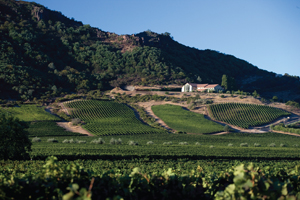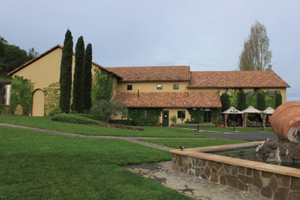Posted on Dec 25, 2018 in
FEATURES,
OENOPHILE
Oenophile | By Denman Moody –

Antica Napa Valley winery.
Photos courtesy of Marchese Antinori.
For 2019, I plan to highlight eleven great wineries and their best wines. Consumers these days appear to be more interested in the story about the people who make the wines and the availability and price of wines of great value – in different price ranges – more than whether the wine tastes like strawberries, graphite, pebbles or dark chocolate.
Wine is a very subjective subject. When Robert Parker took Moody’s Wine Review, which started in January of 1978, and I took The Wine Advocate, which started in June of that same year, we would sometimes, unknowingly, give the same wine the exact or nearly the same score, but we never used the same descriptive terms. The same was true with myself and my friend Michael Broadbent, head of the wine department for many years at Christie’s in London and wine writer for Decanter, which was the London wine magazine of choice for American connoisseurs in the ‘70s and early ‘80s, prior to numerous American wine writers taking up the mantel and focusing on California wines.
While sometimes more than one person could come up with “cassis and black currants,” left bank red Bordeaux descriptives, or “plums,” a right bank red descriptive, I’ve never seen in all these years where two wine writers unknowingly came up with the same four or five adjectives to describe a wine. One realization here is that if you smell peanut butter in the wine you are tasting, and someone says, “there’s no peanut butter smell here,” you can boldly state, and be completely honest – for your palate and olfactory system – “Oh, yes there is!”
While on the subject of tasting wines, there is a myth that if you like White Zinfandel, then you are a beginner. Actually, I love a cold, semi-sweet White Zinfandel with a cold chicken salad on a hot day by the pool – depends on the food being served. There are people who only drink Sauvignon Blanc. I know one – even with a steak! At first, I thought it was my duty to explain that many red wines best served at just a tad below room temperature are vastly superior pairings with a steak than a cold Sauvignon Blanc. But I realized that first, he doesn’t ask for my opinion, and second, he’s 60-years-old and that is what he has figured out is best for him. I sometimes write about my favorite wine and food pairings; some will love them and some will not. Try goat cheese on a cracker with a Sauvignon Blanc, for example.

Antica Napa Valley’s tasting room.
The first wines to make a big splash in America were a cold, fizzy red from Italy called Lambrusco, a semi-sweet white from Germany called Liebfraumilch and of course, Lancers and Mateus, two fizzy rosés from Portugal. The primary sea change (from Europe to here for the consumer) was the advent of the cheap but very sound jug wines of Gallo (Hearty Burgundy), Inglenook (Chenin Blanc), Almaden (Mountain Rhine Wine) and others. Two California wineries were already making great wines: Beaulieu (Cabernet Sauvignon) and Inglenook (Cask Series), but they were almost unknown except in California, because we were not a wine-drinking nation.
Things began to change in the ‘70s as the effects of the Italian and French restaurants always touting and serving their wines, wine writers beginning to appear in large-circulation newspapers and wineries, mainly in California, beginning to make great wines. In 1976, there was a French vs. California blind-tasting in Paris with nine French wine connoisseurs as the judges. Napa’s Chateau Montelena Chardonnay 1973 beat out some of the greatest White Burgundies (Chardonnay, of course), and Napa’s Stag’s Leap Wine Cellars Cabernet Sauvignon 1973 beat out Chateau Mouton Rothschild and Chateau Haut-Brion (primarily Cabernet Sauvignon, of course), each world-renown and from the great 1970 vintage! But we were not yet a wine-drinking nation, so this went pretty-much unnoticed except by the wine industry. As an aside, there’s a great book about this tasting by my friend George M. Taber, who was actually there.
By the ‘80s, we had many world-class wines from wineries like Beaulieu, Joseph Phelps, Duckhorn, Chappellet, Jordan, Robert Mondavi, Far Niente, Spottswoode, Opus One and others, and by the ‘90s, California was rivaling wines made of Cabernet and Chardonnay from anywhere in the world. And today, instead of a mixed drink on every table at dinner at some restaurants, there’s usually a bottle or glass of wine. We’re there!
So, over the next eleven months, I will focus on the story behind eleven of my favorite wineries, the wines they produce and their retail prices, without telling you (falsely for your palate) five meaningless descriptive adjectives for each, which you wouldn’t agree with anyway!

 <
<








